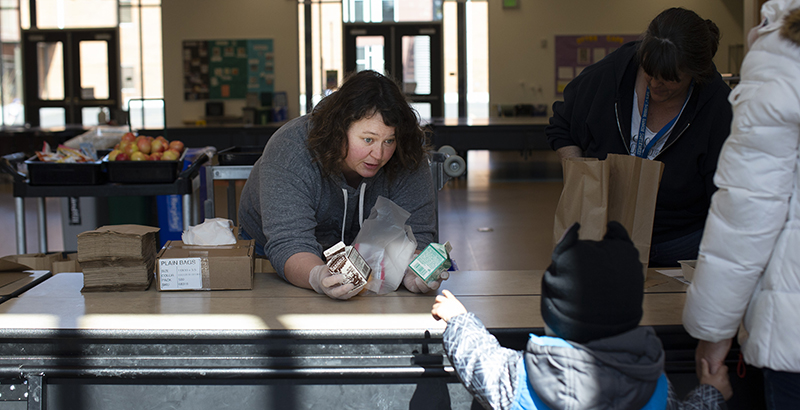Hettleman: Should Wraparound Services Be Funded from School Budgets? Maryland Plan Offers a Cautionary Tale

Get stories like these delivered straight to your inbox. Sign up for The 74 Newsletter
A rapidly growing force in K-12 school reform, accelerated by the pandemic, is wraparound school services. The movement merits support but also requires deeper understanding and caution.
Wraparound programs are generally intended to remove barriers outside of schools that impede student success. They emphasize health and mental health, but also include a wide range of student and family problems that correlate with poverty. Educator Linda Darling-Hammond recently said that to “restart” public schools, we must “think beyond the school doors to include a broad foundation of supports for children, including health care, housing and food.”
Wraparound services are usually joined at the hip with community schools, which are experiencing renewed popularity. These usually employ a school-based coordinator and contain, or link to, outside economic and social programs.
Who can dispute the worth of these impassioned efforts? We know, since the 1966 Coleman Report, that school success is determined more by a family’s economic and educational background than by what happens in the classroom. The 74’s new series on how the pandemic’s economic impact will affect schoolchildren brings this right up to the minute. Many liberal Democrats have insisted for decades that school reformers should focus more on policies and funding outside of schools, like income, health, housing and social welfare, than on conventional in-school reform strategies.
The rub, however, is that there are troublesome trade-offs. Wraparound services outside schools compete for scarce funding that might otherwise go to in-school reforms, such as smaller class sizes, tutoring and other interventions for struggling learners. While the wraparound portion of school budgets is small, it’s been rising.
The Every Student Succeeds Act encouraged use of Title I funds for wraparound services, and many state legislatures are earmarking COVID school recovery funds for similar outside programs. President Joe Biden’s budget proposal for next year would expand community school funding from $30 million to $443 million.
Still, the COVID largesse will soon end, and other federal add-ons are not going to make up the difference. Pre-pandemic, the federal government paid for less than 10 percent of state and local school expenditures. The battlegrounds for adequate and equitable funding will continue to be state legislatures and courthouses.
Historically, wraparound services and community schools have not been factored into such efforts. But Maryland’s recent, widely praised school finance legislation may be a preview of battles in other states.
The Blueprint for Maryland’s Future was enacted right before the pandemic. It adheres closely to the recommendations of the Maryland Commission on Innovation and Excellence, which worked for three years to create a groundbreaking model that would vault Maryland schools from mediocrity to the top in the U.S. and equal to the highest-performing school systems in the world. I was a member of the commission, which succeeded in notable ways.
The blueprint encompasses programs not typically found in school finance methodologies. Wraparound services are the most prominent and are intended to compensate for the fact that the highest-performing school systems around the world— like Finland, Singapore, Shanghai and Ontario — have economic and social welfare programs that are far superior to those in the U.S. and contribute powerfully to student achievement.
In the blueprint, the mechanism for the wraparound and community school funding is an innovative Concentration of Poverty program for individual schools with 55 percent or more low-income students. The program is unique in several respects. It provides each eligible school with a health practitioner, a community school coordinator and a per-pupil grant for each low-income student in the school. Even more significantly, the per-pupil grants are explicitly earmarked for wraparound services and can top $3,000 per child.
Should other states copy Maryland? Unfortunately, in the near future, they should proceed cautiously, if at all. The practical problem is that the program’s wraparound funding appears to have come at least partially at the expense of in-school instruction and basic operating costs. As the blueprint is phased-in over 10 years, the wraparound funding will rise from about 10 percent of additional appropriations to about 25 percent. But there will be little to no increase in funding for programs for all children, including class size reductions, instructional interventions, pupil support, counselors, social workers and security.
This is a startling, fateful departure from the approach taken by the countries with the highest-performing school systems. In those nations, wraparound services generally are not funded by school budgets, but through separate economic and social programs.
Getting comparable economic and social legislation in the U.S. should be a fundamental national goal. It is high on President Joe Biden’s agenda, but its political prospects are uncertain. Therefore, there’s no way to escape the competition between outside wraparound and inside school programs.
How should other states try to resolve this dilemma? Evidence should come first, as Title I and other federal laws already require. A 2017 scholarly review found that “well-implemented community schools lead to improvement in student and school outcomes and contribute to meeting the needs of low-achieving students in high-poverty schools ” — though a 2019 paper concluded that while there may be social-emotional benefits, the effect on student achievement is small.
Overall, the clear weight of evidence strongly supports prioritizing in-school instruction over outside wraparound services.
It’s painful educational triage. But for now, the reality is that fiscally strapped public schools can’t afford to pay for wraparound programs out of their own budgets. Thus, school reformers have the additional burden of rallying for national social and economic programs that will improve the lives of poor and minority families and ultimately boost student achievement.
Kalman R. Hettleman is the author of “Mislabeled as Disabled: The Educational Abuse of Struggling Readers and How WE Can Fight It.” As an advocate, he has represented pro bono more than 250 students in special education and been instrumental in policy reforms at the city, state and national levels. He has been a member of the school board and deputy mayor in Baltimore.
Get stories like these delivered straight to your inbox. Sign up for The 74 Newsletter

;)
